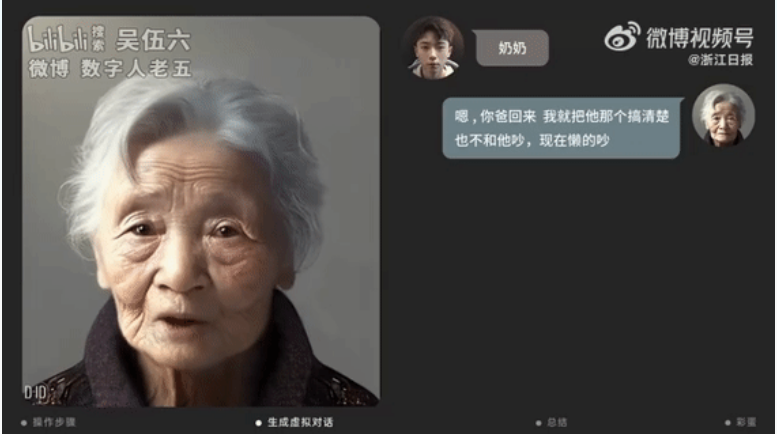
In recent news, a visual designer in Shanghai, known as “Wu Wuliu,” used AI tools to “resurrect” his deceased grandmother and have a conversation with her in a video. In the video, the grandmother speaks in a Hubei dialect, has white hair, and no teeth, just like she did in life. Wu Wuliu stated that the video's purpose was to use AI technology to fill the regret of not having a proper goodbye with his grandmother. However, this video has sparked an enormous controversy. While some netizens want to use AI technology to reunite with their deceased loved ones, others believe that respecting death also respects life, and humans should not attempt to surpass death with technology. The so-called “grandmother” is just a string of cold codes and lacks practical significance.
The question arises: Would you use AI technology to revive your deceased loved ones? If “digital life” becomes famous, what problems might arise? Let’s discuss this topic in detail.
The concept of using AI technology to bring back the dead has been introduced previously. It has been explored in various forms of media, such as movies, TV shows, and books. For example, the famous British TV series “Black Mirror” had an episode where a woman used technology to bring back her deceased partner as a synthetic human. As the artificial human became more and more realistic, the whole scenario became eerie.
The idea of bringing back the dead is both fascinating and terrifying. On the one hand, it offers a chance to reunite with our loved ones and fill the void left by their absence. On the other hand, it raises ethical questions about the boundaries of life and death and the consequences of playing God.
One of the main arguments against using AI technology to bring back the dead is that it blurs the line between life and death. Death is a natural part of life, and it is something that we all have to face eventually. By attempting to bring back the dead, we are essentially denying the natural order of things and disrupting the balance of life. Moreover, creating a “digital life” that mimics a deceased loved one raises the question of authenticity. Is it the same person or just a simulation of them? And if it is a simulation, does it have the same rights and privileges as a living person?
Another argument against using AI technology to bring back the dead is that it is a form of escapism. Death is a painful and inevitable part of life, and it is something that we all have to come to terms with eventually. Using technology to bring back the dead, we avoid the grieving process and deny ourselves the opportunity to move on. Moreover, it can create false hope and lead to unrealistic expectations.

Despite these arguments, there are also valid reasons why someone might want to use AI technology to bring back the dead. For example, it can provide comfort and closure for those who have lost a loved one. It can also be a therapy for people struggling to cope with grief and loss. Additionally, it can be a way to preserve the memories and legacy of a deceased loved one.
However, if “digital life” becomes widespread, it could also lead to many problems. For example, it could create a new form of addiction, where people become obsessed with bringing back the dead and losing touch with reality. It could also lead to a new form of discrimination, where people who cannot afford to create a “digital life” for their loved ones are left behind. Additionally, it could raise legal and ethical questions about the ownership and control of “digital life” and who has the right to access it.
In conclusion, the question of whether we should use AI technology to bring back the dead is a complex and controversial one. While it offers a chance to reunite with our loved ones and fill the void left by their absence, it also raises ethical questions about the boundaries of life and death and the consequences of playing God. Ultimately, it is up to each individual to decide whether they want to use AI technology to bring back the dead. Still, it is essential to consider the potential risks and consequences before doing so.
References
“Shanghai designer uses AI to ‘resurrect’ his dead grandmother and video chat with her.” South China Morning Post, 29 Mar. 2021, https://www.scmp.com/tech/tech-trends/article/3127189/shanghai-designer-uses-ai-resurrect-his-dead-grandmother-and-video.
“Be Right Back.” Black Mirror, season 2, episode 1, Channel 4, 11 Feb. 2013.
“小伙用AI技术“复活”奶奶,一口方言对答如流!网友却吵起来了” https://www.thepaper.cn/newsDetail_forward_22654189